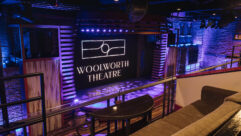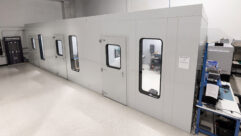
Historic High Tech
Much like the rest of Boston’s downtown area, the John Adams Courthouse (the former Old Suffolk County Courthouse) is an historic building that has seen the world evolve into today’s modern technological society. To keep pace with the times, the Adams Courthouse underwent a massive renovation and construction project that was finished in January 2005.
CHALLENGE: Design modern AV and Web casting systems for newly constructed and renovated courtrooms that are part of an historical courthouse.Because of the historical restoration and nature of the court, Cavanaugh Tocci kept the appeals court audio system very simple. “Conduit could not disturb the fabric of the building,” says Moore. “Since these are appellate courts, there is no need for an evidence presentation system. Audio components such as flexible gooseneck microphones provide the utmost ease of use.”
The newly refurbished courtrooms of the historic John Adams Courthouse offer modern AV amenities, such as live video feeds and courtroom recording systems, while keeping the integrity of the building’s 1894-era style and architecture.
SOLUTION: Create a reliable infrastructure using proven technology, and partner with a nearby law school to host the Web casts.
MUCH LIKE THE REST of Boston’s downtown area, the John Adams Courthouse (the former Old Suffolk County Courthouse) is an historic building that has seen the world evolve into today’s modern technological society. To keep pace with the times, the Adams Courthouse underwent a massive renovation and construction project that was finished in January 2005.
Originally designed by Boston city architect George Clough, the courthouse was completed in 1894 at a cost of about $3.8 million. The recent renovation and construction effort was led by architectural firm CBT Architects under the management supervision of Massachusetts’ Division of Capital Asset Management with a project cost of $147.4 million.
The project included rebuilding the courthouse roof and infrastructure, and adding modern amenities such as updated HVAC, electrical, ventilation, security, and fire protection systems as well as new windows, stairways, elevators, and handicapped-accessible features. The Adams Courthouse has courtrooms and office space for the Supreme Judicial Court, the Appeals Court and the Social Law Library.
To design the Adams Courthouse sound system and acoustics, the architects turned to Cavanaugh Tocci Associates, an audio and acoustical consulting firm in Sudbury, Mass. “Our firm got involved in the project back in 1993 for early schematic design work,” says Matthew Moore, principal consultant at Cavanaugh Tocci. “In late 2000, we completed the sound system and acoustical design.”
Moore worked with John Foulkes and Tony Hoover, both of Cavanaugh Tocci, to fill the scope of work that included acoustical design, sound reinforcement, courtroom recording systems, evidence presentation systems and a video system capable of providing feeds to the press and others in the building.
In the new construction portion of the Adams Courthouse, the Supreme Judicial Court occupies two courtrooms, including the largest called the seven-justice courtroom, which gets its name from the seven justices that sit on the bench. This courtroom is often used for high-profile trials and hearings. Moore says, “This was a challenging architectural environment, because of the large skylight in the middle of the ceiling and because of the many soffits in the room.”
Speech intelligibility was an important goal, and locating loudspeakers was difficult. The sound system is a mix-minus system using Audax HP080G0 speakers installed around the judge’s bench, lawyer and clerk. There are Atlas Sound FC104T47 ceiling speakers installed over the main audience gallery and the adjacent viewing room.
Historic High Tech
Much like the rest of Boston’s downtown area, the John Adams Courthouse (the former Old Suffolk County Courthouse) is an historic building that has seen the world evolve into today’s modern technological society. To keep pace with the times, the Adams Courthouse underwent a massive renovation and construction project that was finished in January 2005.
Order in the Court
The courtroom uses Shure MX-418/S miniature, unidirectional microphones. An IED 3200 system and QSC CX-302V amplifiers power the entire system. The courtroom’s main equipment racks are Lowell Manufacturing L275-77s while Middle-Atlantic SRS4-20 racks are for use under a counter.
Sennheiser models, including two SI-1015NT transmitters and RI-250 receivers, comprise the assisted listening system. Cavanaugh Tocci developed the court recording system performance specifications after extensive evaluations with the courts IT department. CourtSmart Digital Systems, a manufacturer in North Chelmsford, Mass., designed and installed a system that best met the courts’ needs.
In a move to tone down distractions while maintaining transparency for high-profile hearings, the seven-justice courtroom features a video system that can send multiple feeds to parties outside the room. According to Moore, the public affairs department requested this capability to give local TV stations and the public access to live proceedings without being in the courtroom. “It was part of the new construction, so there was flexibility in terms of equipment locations. We could build the technology into the room,” says Moore.
COURTSMART COURT REPORTING SYSTEM
The CourtSmart recording system takes in each of the eight incoming audio channels from each courtroom on both primary and redundant backup servers. Should the courthouse decide to add video recording, a simple installation of software and servers would expand the system capabilities.
Credit: Courtesy of Courtsmart
In Boston’s John Adams Courthouse, CourtSmart Digital Systems developed and installed the court reporting system. CourtSmart is a North Chelmsford, Mass., software development company that uses industry standard hardware, such as computers and microphones, for its recording systems.
The company develops, sells and manages its systems and can offer turnkey solutions as well as systems integration. For this project, CourtSmart began its installation after the audio and IT infrastructure was in place.
Its systems use dedicated audio cabling and servers while connecting to the courthouse network for searching and playback. By monitoring the ambient noise of the courtroom, CourtSmart can begin and end recording automatically. Users also can choose to control manually the recording process. Once the audio is recorded and automatically digitized, the files are available to users. All users are secure to three levels — identity, location and file rights — to prevent unauthorized access.
To ensure the system’s reliability and availability of the recording, CourtSmart is a fault-tolerant system that operates with redundant servers. It also provides an auto-backup feature; the system writes the recorded files to a DVD, prints the disc, and then completes a binary code check to verify it.
The company uses industry standard database management systems that allow it to work with the courthouse case management system for integration and searches.
Bob Wey of Ear-Relevant Sounds in Weston, Mass., designed the video system, beginning his planning in 2000. “When a big trial was happening, the local TV stations would get the call and would bring in satellite trucks and cables. At times, it would be so chaotic with so many TV crews, that cables were run through the windows to get to the control room,” says Wey. “Now they can send the video feed to intrabuilding, to recording equipment, out to the Webcast, outside to wall panels, and to an overflow area so the press doesn’t have to sit outside.”
In the seven-justice courtroom, four Sony DXC390 cameras are mounted in fixed locations and installed in a way as to blend with the architecture. Wey used these Sony cameras because they met his criteria of near-studio quality video at the right price.
“All cameras are inconspicuously mounted, often hidden in the millwork whenever possible,” said Wey.
Camera 1, or the “Justice camera,” works on eight presets, one for each of the seven justices plus a whole bench view.
Camera 2, or the profile camera, is mounted on the side of the bench and shoots across it for a profile view.
Camera 3, or the lectern camera, shoots via a hole in the wall behind the justices.
Camera 4, or the gallery camera, is mounted in the back and provides a room shot.
A control room connected to the seven-justice courtroom handles all the feeds; an operator chooses the camera shots to send out for the press feed. AutoPatch performs the switching, and Extron components do the routing. “I chose Extron because they are reliable, and the company has good customer service,” says Wey.
Custom-built video feed panels for the press are in several locations. Those used outside are weather-tight to protect against the harsh New England elements. Each panel uses 24 BNC video connectors and measures 16 inches wide by 12 inches high.
One feed coming from the control room goes directly into the Web casting system, which was designed Stewart Randall, CTS-D, a principal consultant of Communications Design Associates Inc., a consulting firm in Norwood, Mass. Randall joined the project based on his firm’s working relationship with Cavanaugh Tocci. “The court wanted Web casting capability so they could be more transparent and accountable to the general public,” says Randall. “Now, all sessions are available on the Web for law practitioners and the public to view.”
Historic High Tech
Much like the rest of Boston’s downtown area, the John Adams Courthouse (the former Old Suffolk County Courthouse) is an historic building that has seen the world evolve into today’s modern technological society. To keep pace with the times, the Adams Courthouse underwent a massive renovation and construction project that was finished in January 2005.
Linda Seid Frembes is a magazine journalist and public relations consultant for the professional AV industry. Visit her at www.frembes.com.
A partnership with Suffolk University makes the Web casting system possible. Greg Comeau, managing associate director of University Media Services at the Suffolk University Law School worked with Cavanaugh Tocci and Randall on system specification and capability.
FOR MORE INFORMATION
Atlas Sound
www.atlassound.com
AutoPatch
www.autopatch.com
CourtSmart
www.courtsmart.com
Extron
www.extron.com
Lowell Manufacturing
www.lowellmfg.com
Middle Atlantic
www.middleatlantic.com
Proxim
www.proxim.com
Sennheiser
www.sennheiser.com
Shure
www.shure.com
Sony
www.sony.com
Starbak
www.starbak.com
VBrick Systems
www.vbrick.com
Randall’s design takes the video feed from the courtroom and sends it to the roof, where it is broadcast via a microwave wireless link across the street to a Suffolk University building. The wireless is a secure connection using a 2.4 GHz encoded and encrypted data stream with proprietary technology by Proxim Wireless, manufacturer of the Tsunami wireless bridge. From there, the signal downlinks to Suffolk University servers and is converted to Windows Media files, says Randall. “It is economical, since there is no need to rent fiber and is a one-time capital expenditure for the equipment,” he says.
The internal Webcast lets people in the courthouse monitor what is happening in each courtroom via VBrick MPEG-4 video that is sent to desktops within the building with a VBrick player. External Internet users can see the live stream, directed by Erlyn Ordinario of University Media Services, generated by Starbak MPEG-2 video using standard Windows components.
To address any security concerns, the Webcast does not touch the Supreme Judicial Court network. Randall’s design established a separate network to sidestep security and bandwidth issues. Both fiber for the video and copper for the control system are run up to the roof; Suffolk University already had their infrastructure in place.
Testing of the Web casting system began in May 2005. The Adams Courthouse live “gavel-to-gavel” coverage was an instant hit with attorneys, students, the media, and the general public. According to the Supreme Judicial Court, the Webcast had 947 viewers on a single day. One of the first cases Webcast live was a hearing before the Supreme Judicial Court in which the Catholic Action League of Massachusetts was moving to have the court set aside the landmark ruling that legalized same-sex marriage in Massachusetts.
The lead installer on the project was Ostrow Electric, which also brought in Univisions Crimson and Central Communications, was the lead installer on the project. HB Communications installed the Web casting system.










